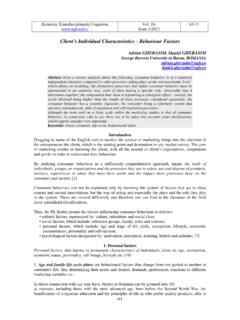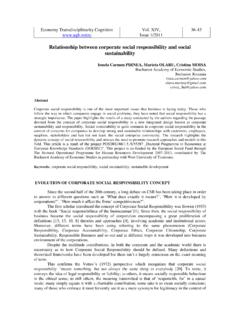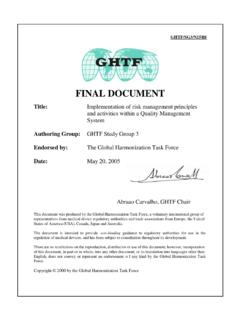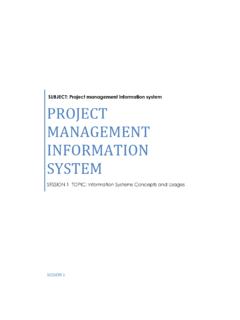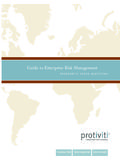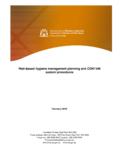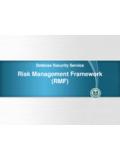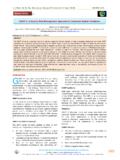Transcription of Risk Management and Quality Management an Integrate …
1 55 Economy Transdisciplinarity Cognition Vol. 19, Issue 1/2016 55-61 Risk Management and Quality Management an Integrate Approach Andrei Octavian PARASCHIVESCU George Bacovia University, Bacau, ROMANIA Abstract: The work is based on a synthesis of the new guidelines in theory of Quality , risk Management and integrated, concepts in permanent correlation. The solutions presented show, in terms of Management , Quality and risk a permanent correlation, becoming a new managerial strategy for any organization. Analysis, risk assessment and prevention in the field of Quality are complex activities that require multidisciplinary approach, the culture of Quality and accountability. Results of the analysis, of the evaluation and risk prevention decisively influence decisions and the success of the strategies adopted at the macro and microeconomic level.
2 Keywords: Quality , Risk, Integrating Systems, Risk and Quality Management Introduction In any business or organizational environment, we are talking about risk all the time, referring to the Management , prevention, effects etc. Risk Management must be part of the organization's strategy in the field of Quality . The term "risk" was introduced in ISO 9000 in 2008 when it was suggested in relation to the environment organization which must operate in relation to legal strengths, based on regulations and competitiveness, so that the adoption of a Quality Management system (QMS) is a strategic decision of the organization. The new edition of ISO 9001 2015 pays special attention to risk Management , including a new chapter - Risk Management in the field of Quality . Quality Management system provides the necessary framework for continuous improvement of product and service Quality , increase customer satisfaction and strengthen confidence of all stakeholders.
3 risks have become important and must be aware of each manager. They are not just a problem of perception, they are real. The threat of failure or liquidation of bankrupt of the enterprises, the loss of customers or increasing prices are real phenomena in production systems and services, evolving under uncertainty circumstances. The concept of integrated Management system risk has evolved acquiring new dimensions and perspectives on the premise that a company needs a comprehensive Management and organizational concept, so existing systems, focused on the same topic to be associated. Designing and implementing a system of integrated Management risk in accordance with applicable standards, it should be a priority concern and permanent decision makers at every level, because this action can be materialized in a longer period shorter time to assess the real potential of organizations.
4 The risk assessment has been an increasingly important topic in the processes of decision-making in many areas: business, finance and banking, medicine, engineering, biology, chemistry, aeronautics, etc. Risk analysis should be carried out in the early stages of the processes within the Quality Management system , thus contributing to the systematic identification, the analysis of the frequency and severity of these risks , in order to prevent / reduce / eliminate these risks and strengthening the role of Total Quality Management . Today many organizations have QMS procedures fully functional and certified. Maybe it is time to accept the risk mitigation actions in all QMS processes. Risk is not a bad thing or the wrong word. 56 There is a lot of uncertainty in any effort. The risk is linked to the way we learn, innovate and / or open new frontiers and levels of understanding.
5 There are no companies and technologies without risks . 1. The Necessity to Approach Risk Management in the Field of Quality Why repeating what we had to do once, but better? Why pay non- Quality ? Why not offer complete satisfaction of customers? These are questions to which great Quality scientists worldwide tried to find an answer. Among these we can mention the renowned Juran, Deming, Crosby, Shingo etc., and also the major organizations dedicated to Quality (World Alliance -WAQ for Quality , European Foundation for Quality Management - EFQM). 85% of the causes of customer dissatisfaction resulting from a lack of efficiency of systems and processes, not in the way employees work. The role of Management is to improve processes, not pushy to ask people to work better stated Deming. Growing strongly in recent years, the literature addresses the issue of Quality -integrated risk with the support of an integrated Management .
6 [4], [5], [7], [9]. Supporting this idea it stands the following arguments: The risk is closely related to customer dissatisfaction, or SMC's main objective is customer satisfaction. Preventing, eliminating the risk actually means ensuring customer satisfaction; The framework for Risk Management shows that it is increasingly necessary to intensify concerns for integrating Risk Management under the new Management organization; Increase efforts to introduce integrated Management systems in organizations; Risk Management is needed in many areas: public health, pharmacovigilance, safety, energy security, business, finance and banking etc.. and is a valuable component of an effective Quality system , even if the benefits they can offer not yet reflected enough on best practices; Increase at a pace unprecedented situations of risk and uncertainty; Increasing importance given to risk study and to the incertitude by researchers from different fields.
7 Most definitions of risk Management focuses on threats and the tools and techniques that appeal in this regard, it is focused more on negative risk component. Relatively recently, the concept of risk approach included a positive component, meaning the ability to create opportunities through a strategy and a proper Management . The new definitions oriented and positive component of risk began to emerge, especially after 1999. For example, in 2000, British Standard Institute (BSI) states that the risk is "uncertainty .. which affect the possibility of achieving the objectives", and standards developed in Australia and New Zealand presents a definition that allows the incorporation of threats, but also of the opportunities. Dr. David Hillson, British specialist recognized for his contributions in the field of risk Management , states that "the use of the word" risk "only in a negative sense, is incorrect because it changes the meaning of this word, derived from the Latin (resecare = dare.)
8 Leading to the optimization)". [6, 36] The risk is considered as "An uncertain event or condition, if it has positive or negative effect Occurs on the project's objectives techniques" [15, 373]. "Risk includes both threats and opportunities objectives to improve these objectives". [15, 262] "Risk Management is a cyclical process in which one learns .. Risk Management is not an activity isolated from the activities of Management ". [12, 46] Risk Management is defined as the act or practice of keeping risk under control and include: identification, planning, Management , monitoring, adaptive Management operations to change and documenting risks [11, 7]. According to ISO 31000: 2009, Risk Management is a set of "coordinated activities to direct and control an organization with regard to risk. The risk has a double significance 57 probability for the impact too.
9 "The activities within a process / project are accompanied by risk and uncertainty because they involve obtaining future results. [10, 8] Today, Quality is the key to staying competitive and risk Management is strengthened by adding to the equation. Both risk Management and Quality Management strategies must find ways to take account of uncertainty. Risk Management is implicit in the daily tasks of a successful professional in Quality Management . 2. Systems Integration In the field of Management systems there exists the belief that many organizations having multiple Management systems become ineffective and some have created the idea of integrating these systems. The road was opened to embedded systems with integrated documentation standards and then by integrating the standards and of the functions / structures of risk Management and strategic decisions.
10 The advantages of integration are presented by Hoyle [7, 121] as a way to reduce risk, so the same system integration and risk Management system . An example of a guide to the integration of Management systems offered in 2006 the UK Institute of Occupational Health and Safety (IOSH), which treated the subject of integration with respect to organizational structures, strategic decision-making, resource allocation, auditing processes and performance analysis. [7, 125] In the context of Management , integration might be putting all the internal Management practices into one system or bringing together separate disciplines to work on a problem, or joining the processes that serve a particular objective. Integrated Management is the understanding and effective direction of every aspect of an organization so that the need and expectations of all stakeholders are equitably satisfied by the best use of all resources.

